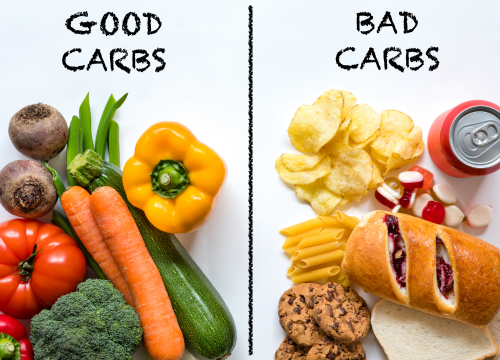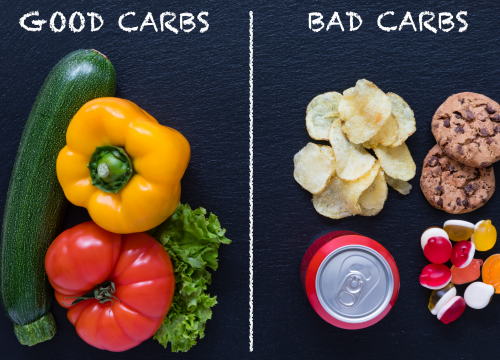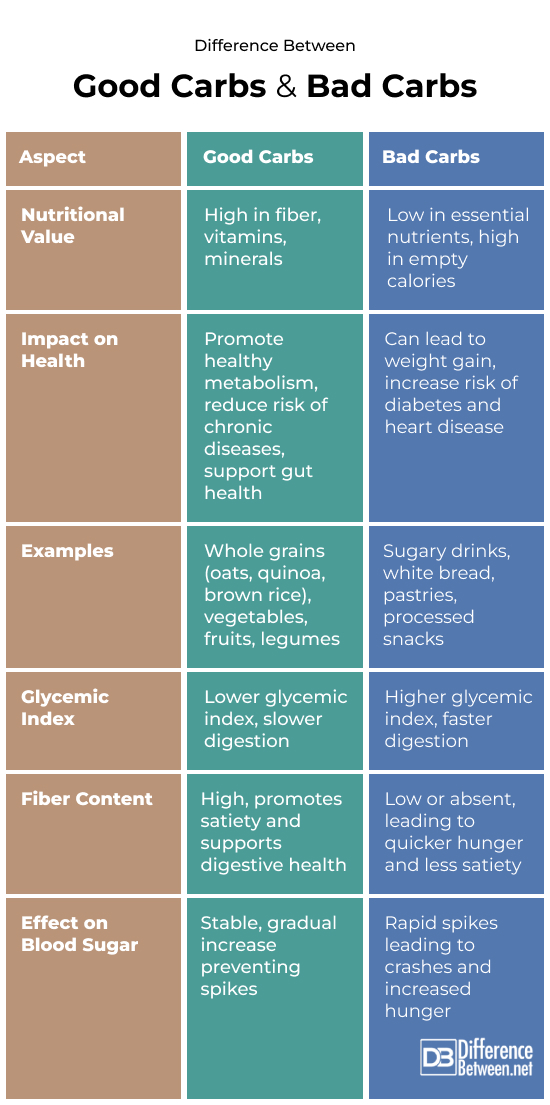Difference Between Good Carbs and Bad Carbs
Introduction
Dietary carbohydrates are the body’s principal energy source. But not all carbs are equal. Good and bad carbohydrates must be distinguished for optimal health, weight management, and chronic disease prevention. This article explains the distinctions between these two carbs to help you eat healthy.
So what are carbs?
Proteins, lipids, and carbohydrates are the three macronutrients needed for health. Fruits, vegetables, cereals, and dairy products include them, which provide glucose, the body’s primary energy source. Simple and complicated carbohydrates exist. Simple carbs have one or two sugar units and are easily absorbed, causing blood glucose to increase. Example: table sugar, honey, milk, and fruit. Complex carbs have longer sugar chains, which slow digestion and release energy slowly. Complex carbs are found in whole grains, legumes, and starchy vegetables.

What are good carbs? Their benefits?
Complex carbohydrates—good carbohydrates—are essential to a balanced diet. Complex carbs contain fiber, vitamins, and minerals, making them healthy. Unprocessed food like whole grains, fruits, vegetables, and legumes (including beans, lentils, and peas) are healthy foods that have high amount of good carbs.
Benefits:
These foods are high in fiber, which slows digestion process. This slows glucose absorption. It doesn’t raise blood sugar quickly as simple carbs. This simplifies blood sugar management. Fibers help prevent constipation by enhancing bowel movements.
They help in weight management. Complex carbohydrate foods keep you feel full longer, preventing snacking and hunger. These meals provide the vitamins and minerals the body needs for immunological support, bone health, and vitality due to their high nutrient density.

What are bad carbs? Why are they bad?
Unlike complex carbs, this type of carbs are very different; They are usually called simple sugars and processed carbs. These have very little nutritional value and are quickly absorbed by the body, which causes blood sugar levels to rise quickly. The added sugars in processed foods are what you need to watch out for. Simple sugars are usually found in foods like milk and fruits. Simple carbs are processed to remove the bran and germ, which means they don’t have any fiber, vitamins, or minerals.
Where They are found?
Sugary drinks like soda and energy drinks, white bread, pastries, and other prepared snacks are all common places to get bad carbs.
How do they affect health?
There are a lot of bad things that happen when you eat a lot of bad carbs.
First, these carbs can make it harder to stick to a healthy diet because they cause fast increases in blood sugar. This can make you feel tired and hungry all the time. A diet high in bad carbs can make you gain weight over time because it gives you extra calories without making you feel full, which makes you eat more than you need to.
In addition, the effects on health go beyond weight. When you eat a lot of bad carbs, you raise your chances of getting type 2 diabetes, heart disease, and some types of cancer. Glucose and insulin levels can rise quickly, which can make it hard for the body to control glucose. This can cause insulin resistance and other metabolic problems.
Possible Similarities Between Good and Bad Carbs
Although different, good and bad carbohydrates have certain key similarities:
- Both healthy and bad carbs provide energy to the body. Breaking down carbohydrates into glucose provides energy for biological processes and physical exercise.
- Both forms of carbohydrates are included in many diets worldwide. Most diets include carbs, whether whole or processed.
- Carbohydrates affect mood and brain function by raising blood sugar and releasing serotonin, a neurotransmitter that promotes happiness.
Comparison of Good and Bad Carbs
- Glycemic Index and Load: The GI shows how quickly carbohydrate-rich foods elevate blood sugar. Good carbs raise blood sugar slowly due to their low to medium GI. Due to their high GI, poor carbohydrates raise glucose levels quickly. This is more complete because glycemic load (GL) measures how quickly a dish raises blood sugar and how many carbs it contains. Lower-GL foods help control blood sugar.
- Comparing Nutrition: Healthy carbs contain vitamins, minerals, and fiber. They are made from minimally prepared whole foods. Bad carbs lose nutritional value during processing, creating high-calorie, low-nutrient foods.
- Eating good carbs can assist your metabolism and lessen your risk of chronic diseases like type 2 diabetes, heart disease, and some malignancies. They aid weight loss, cholesterol reduction, and gut health. Bad carbs can cause weight gain, insulin resistance, metabolic syndrome, and other long-term disorders.
- Different foods digest differently based on their fiber content. Fiber is essential for healthy carbohydrates. It slows glucose digestion and absorption, so it gives you energy slowly and stabilizes blood sugar. Good carbs are abundant in fiber, which fills you up and aids digestion. Due to their poor fiber content, bad carbohydrates expedite digestion and elevate blood sugar and insulin levels. This can alter your body’s appetite and fullness signals, making overeating simpler.
Difference Between Good Carbs and Bad Carbs

Summary
Identifying good and bad carbs is essential for a healthy diet. Good carbohydrates, with high fiber content and low glycemic indices, are mostly found in unprocessed, whole foods and have many health benefits, including stabilized metabolism, reduced risk of chronic diseases, and improved gastrointestinal health. Bad carbs, such as processed and refined foods with high glycemic indexes, cause obesity, diabetes, and cardiovascular disease. Thus, eating nutrient-rich carbohydrates instead of processed sugars and flours can improve health and vitality. This discourse emphasizes carbohydrate quality discernment in a nutritionally sound diet, especially for an academic audience interested in optimal diets.
FAQs
What are good carbs and bad carbs?
Good carbs are nutrient-dense, high in fiber, and low in the glycemic index, found in whole, unprocessed foods like whole grains, vegetables, and legumes. Bad carbs are low in nutrients and high in the glycemic index, commonly found in processed and refined foods like sugary drinks and white bread.
What is the number 1 worst carb?
The number 1 worst carb is often considered to be high-fructose corn syrup, found in many processed foods and beverages, due to its strong association with obesity, diabetes, and other health issues.
Which are the healthiest carbs?
The healthiest carbs are those that are minimally processed and include whole grains, vegetables, fruits, and legumes, providing essential nutrients, fiber, and a low glycemic impact.
Are bananas good carbs or bad carbs?
Bananas are considered good carbs because they are rich in nutrients, including potassium and fiber, although they are higher in natural sugars than some other fruits.
What’s the worst carb you can eat?
Refined grains and processed foods with added sugars, such as white bread, pastries, and sugary drinks, are among the worst carbs due to their poor nutritional value and negative impact on health.
Are potatoes good or bad carbs?
Potatoes are considered good carbs when eaten in their whole form and with moderation, as they are a natural, nutrient-rich food source. However, their preparation method can affect their nutritional value.
Which carb is worse, bread or potato?
This depends on the type of bread and how the potato is prepared. Generally, whole grain bread may be healthier than white bread or overly processed potato dishes, but a whole, baked potato can be quite nutritious.
Are carbs from fruit bad?
No, carbs from fruit are not bad. While fruits contain natural sugars, they are also rich in vitamins, minerals, and fiber, making them a healthy part of a balanced diet.
What is better, potatoes or rice?
Both can be part of a healthy diet if chosen wisely. Whole, unprocessed potatoes and brown rice are preferable for their nutrient content and fiber. The choice may depend on individual dietary needs and personal preference.
- Difference Between Suicide and Euthanasia - May 22, 2024
- Difference Between Vitamin D and Vitamin D3 - May 21, 2024
- Difference Between Running Shoes and Walking Shoes - April 30, 2024
Search DifferenceBetween.net :
2 Comments
Leave a Response
References :
[0]Brand-Miller, J., McMillan-Price, J., Steinbeck, K., & Caterson, I. (2008). Carbohydrates--the good, the bad and the wholegrain. Asia Pacific journal of clinical nutrition, 17.
[1]Greenwood-Robinson, M. (2003). Good Carbs Vs. Bad Carbs. Penguin.
[2]Greenwood-Robinson, M. (2003). Good Carbs Vs. Bad Carbs. Penguin.
[3]Greenwood-Robinson, M. (2003). Good Carbs Vs. Bad Carbs. Penguin.
[4]Greenwood-Robinson, M. (2003). Good Carbs Vs. Bad Carbs. Penguin.
[5]Greenwood-Robinson, M. (2003). Good Carbs Vs. Bad Carbs. Penguin.
[6]Greenwood-Robinson, M. (2003). Good Carbs Vs. Bad Carbs. Penguin.
[7]Greenwood-Robinson, M. (2003). Good Carbs Vs. Bad Carbs. Penguin.
[8]Brand-Miller, J., McMillan-Price, J., Steinbeck, K., & Caterson, I. (2008). Carbohydrates--the good, the bad and the wholegrain. Asia Pacific journal of clinical nutrition, 17.
[9]Brand-Miller, J., McMillan-Price, J., Steinbeck, K., & Caterson, I. (2008). Carbohydrates--the good, the bad and the wholegrain. Asia Pacific journal of clinical nutrition, 17.
[10]Brand-Miller, J., McMillan-Price, J., Steinbeck, K., & Caterson, I. (2008). Carbohydrates--the good, the bad and the wholegrain. Asia Pacific journal of clinical nutrition, 17.
[11]Image credit: https://www.canva.com/photos/MAEDz8VPGtc-good-carbs-versus-bad-carbs/
[12]Image credit: https://www.canva.com/photos/MAEDz0OFqfc-good-carbs-versus-bad-carbs/

Learning about good carbs vs bad carbs is one of the most crucial things for someone going on a diet or trying to lose weight.read more…
The sentence “Calories are not present in bad carbs -they are empty and their nutritional value is minimal. ” is half correct.
There are plenty of calories in bad carbs but they are empty calories, their nutritional value is minimal.